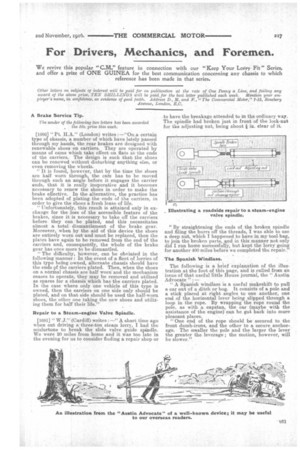For Drivers, Mechanics, and Foremen.
Page 21

If you've noticed an error in this article please click here to report it so we can fix it.
We revive this popular "CM." feature in connection with our "Keep Your Lorry hit" Series, and offer a prize of ONE GUINEA for the best communication concerning any chassis to which reference has been made in that series.
Other letters on subjects of interest will be paid for on publication at the rate of One Penny a Line, and failing any award of the above prize, TEN SHILLINGS will be paid, for the best. letter published each week. Mention your employer's name, in confidence, as evidence of good faith. Address .D., .M. and F., "The Oommercial Motor," 7-15, klosebery Avenue, London, B.C.
A Brake Service Tip.
The sender of the following two letters has been awarded „ the 10s, prize this week.
[1680j "Pt. HA." (London) writes :—"On a certain type of chassis, a number of which have lately passed through my hands, the rear brakes are designed with
renewable shoes on carriers. They are operated by means of cams which take effect on flats at the ends of the carriers. The design is such that the shoes can be renewed without disturbing anything else, or even removing the wheels. " It is found, however, that by the time the shoes are half worn through, the cam has to be moved through such an angle before it engages the carrier ends, that it is really inoperative and it becomes necessary to renew the shoes in order to make the brake effective. In the alternative, the practice has been adopted of plating the ends of the carriers, in order to give the shoes a fresh lease of life. . " Unfortunately, this result is attained only in exchange for the loss of the accessible feature of the brakes, since it is necessary to take off the carriers
before they can be plated, and this necessitates almost a total dismantlement of the brake gear.
Moreover, when by the aid of this device the shoes are entirely worn out and must be replaced, then the plates have again to be removed from the end Of the carriers and, consequently, the whole of the brake gear has once more to be dismantled. "The difficulty, however, can be obviated in the following manner: In the event of a fleet of lorries of this type being. owned, alternate chassis should have the ends gf the carriers plated. Then, when the shoes on a normal chassis are half worn and the mechanism ceases to operate, they may be removed and utilized as spares for a chassis which has the carriers plated. In the case where only one vehicle of this type is owned, then the carriers on one side only should be plated, and on that side should be used the half-worn shoes, the other one taking the new shoes and utilizing them for half their life."
Repair to a Steam-engine Valve Spindle.
[1681] "W.J." (Cardiff) writes : —" A short time ago when out driving a three-ton steam lorry, I had the misfortune to break the slide valve guide spindle. We were 20 miles from home and it was toe late in the evening for us to consider finding a repair shop or .to have the breakage attended to in the ordinary way. The spindle had broken just in front of the lock-ma for the adjusting nut, being about in. clear of it.
"By straightening the ends of the broken spindle and filing the burrs off the threads, I was able to use a deep nut, which I happened to have in my tool bag, to join the broken parts, and in this manner not only did I run home successfully, but kept the lorry going for another 400 miles before we completed the repair."
The Spanish Windlass.
The f ollowing is a brief explanation of the illustration at the foot of this page, and is culled from in issue of that useful little House journal, the "Austin Advocate " :— "A Spanish windlass is a useful makeshift to pull a car out of a ditch or bog. It consists of a pole and a stick placed at right angles to one another, one end of the horizontal lever being slipped through a loop in the rope. By wrapping the rope round the pole, as with a capstan, the car (maybe with the assistance of the engine) can be got back into more Pleasant places. "One end of the rope should be secured to the front dumb-irons, and the other to a secure anchorage. The smaller the pole and the larger the lever the greater the leverage ; the motion, however, will be slower."






















